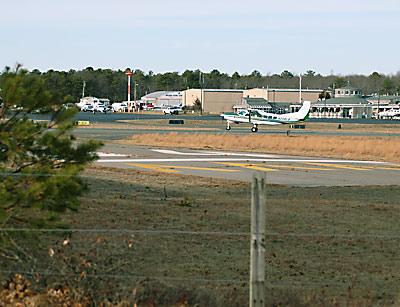F.A.A. Sheds Light on Airport Control Queries

Decisions about East Hampton Airport — if, how, and whether the town should seek to impose restrictions on its use to try to cut down on aircraft noise — have been fraught with questions about what authority the town may actually wield, under both federal laws and the town’s contractual agreements with the Federal Aviation Administration, and about the potential repercussions should the town overstep its authority.
Aviation-specialty attorneys consulted by both the town and by private groups such as the Quiet Skies Coalition, formed to address the problem of airport noise, have outlined the applicable laws, but painted different pictures about the possibility of a successful outcome if East Hampton tries to limit use of the airport during certain hours or by particular types of planes.
Now, for the first time, the Federal Aviation Administration has provided answers to direct questions about the town’s standing as far as controlling the airport.
The answers, in the Quiet Skies Coalition’s view, demonstrate that, when certain grant assurances expire at the end of 2014, the town will be able to enact new airport regulations that could reduce noise. The assurances — contractual obligations to the F.A.A. — are set in place when the town accepts federal grants for the airport.
Representative Tim Bishop, acting on a request from the Quiet Skies Coalition and other parties, submitted a list of questions to Michael Huerta, the F.A.A. acting administrator, in mid-December, and distributed the responses last week.
After Dec. 31, 2014, the F.A.A. wrote, “unless and until the F.A.A. awards a new grant to the town, the F.A.A. will not initiate or commence an administrative grant enforcement proceeding in response to a complaint from aircraft operators. . . .” about airport use restrictions such as a nighttime curfew.
The expiration in two years of several grant assurances, the result of a lawsuit settlement between the F.A.A. and the Committee to Stop Airport Expansion, a private East Hampton group, has been hailed by airport noise control advocates as an opportunity for the town.
They opposed the town board’s recent submission of a grant application for money to design and plan the installation of a security fence around the airport. Taking new money from the F.A.A. will set all of the grant assurances in place again for a new 20-year period.
Unless extended by the town’s acceptance of new grants, the rest of the existing grant assurances will expire in 2021.
Peter Kirsch, the town’s airport attorney, said in a presentation to the town board in December that “there is considerable legal uncertainty about what would happen in 2021 with no new F.A.A. grants. Resolving that uncertainty would cost millions in litigation.”
Mr. Kirsch described for the board the extensive efforts made by several other municipalities to get the F.A.A. to approve airport use restrictions on certain types of aircraft, including helicopters, under a federal law called the Airport Noise and Capacity Act of 1990.
But in its responses to the questions submitted by the congressman, the agency notes that in East Hampton’s case, “the F.A.A.’s agreement not to enforce also means that unless the town wishes to remain eligible to receive future grants of federal funding, it is not required to comply with the requirements under the Airport Noise and Capacity Act of 1990 [. . .] in proposing new airport noise and access restrictions.”
“Beginning January 1, 2015, the Town can impose reasonable, non-arbitrary, and nondiscriminatory, hours of operation, curfews, and other access limitations in order to protect the community from demonstrated airport noise,” the Quiet Skies Coalition wrote in its press release.
“This clarification by the F.A.A. makes clear that the only F.A.A. risk from imposing reasonable noise limits is the ineligibility for F.A.A. financial subsidy, which the town will not need anyway, if it operates the airport on a sound, business-like basis,” said Charles Ehren, a member of the coalition’s executive committee, in the press release.
Kathleen Cunningham, the organization’s chairwoman, added, “Finally! We have unequivocal clarification from the very organization the town’s been afraid to challenge. Being free of ANCA regulations is something we’ve been dreaming of for a while now. Surely now, the town will recognize the benefits of exercising their rights as proprietor, while still operating a safe airport.”
However, the F.A.A. writes in its response to Mr. Bishop, “should the town of East Hampton propose any restriction that denies access on fair and reasonable grounds or is unjustly discriminatory [ . . . ] federal and constitutional law would provide a basis for aircraft operators to prevail in seeking a declaratory judgment and injunction.” In addition, the F.A.A. could also bring suit.
But the agency acknowledges that airport proprietors are “vested [only] with the power to promulgate reasonable, non-arbitrary, and nondiscriminatory regulations that establish acceptable noise levels for the airport and its immediate environs.”
“Should the town and the F.A.A. have a difference of opinion concerning whether proposed restrictions exceed this limitation, it is an open question whether the United States could and would initiate” a lawsuit against the town, even after the grant assurances expire, the F.A.A. wrote.
In conjunction with seeking the new F.A.A. grant for the airport fence, the town board has embarked, with Mr. Kirsch’s assistance, on a multipronged plan to mitigate airport noise, with initial measures based on pilots’ voluntary compliance with town rules.
Meanwhile, court review continues of a new lawsuit from the Committee to Stop Airport Expansion challenging the town’s adoption of an airport master plan, on the basis that the impact of airport noise was not properly addressed. The group also sought an injunction to prevent the town from signing a new grant agreement with the F.A.A.
